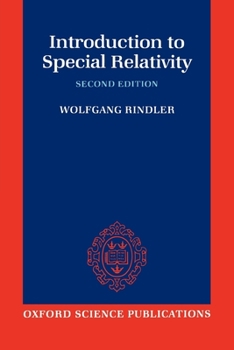Introduction to Special Relativity
Select Format
Select Condition 
Book Overview
This textbook offers a concise but thorough treatment of the theory of special relativity for advanced undergraduate and beginning graduate students. Assuming no prior knowledge of relativity, the author elaborates the underlying logic and describes the subtleties and apparent paradoxes. The text also contains a large number of problems which cover the basic modes of thinking and calculating in special relativity. Emphasis is placed on developing the student's intuitive understanding of space-time geometry along with the necessary methods of four-tensor calculus, though three-dimensional methods are also described. This updated new edition contains additional examples and problems, and the chapter on relativistic mechanics of continua has been substantially rewritten.
Format:Paperback
Language:English
ISBN:0198539525
ISBN13:9780198539520
Release Date:July 1991
Publisher:OUP Oxford
Length:180 Pages
Weight:0.65 lbs.
Dimensions:0.5" x 6.1" x 9.2"
Customer Reviews
3 ratings
Best and most accessible intro to special relativity
Published by Thriftbooks.com User , 18 years ago
The special theory of relativity was proposed in 1905 by Albert Einstein in his article "On the Electrodynamics of Moving Bodies". Some three centuries earlier, Galileo's principle of relativity had stated that all uniform motion was relative, and that there was no absolute and well-defined state of rest; a person on the deck of a ship may be at rest in his opinion, but someone observing from the shore would say that he was moving. Einstein's theory combines Galilean relativity with the postulate that all observers will always measure the speed of light to be the same no matter what their state of uniform linear motion is. This theory has a variety of surprising consequences that seem to violate common sense, but which have been verified experimentally and overthrows Newtonian notions of absolute space and time by stating that distance and time depend on the observer, and that time and space are perceived differently, depending on the observer. This book assumes no prior knowledge of relativity, and I have found it great as a device for self-teaching this fascinating subject. It elaborates on the underlying logic, dwells on the subtleties and apparent paradoxes, and contains a large number of problems which cover all the basic modes of thinking and calculation in this discipline. The viewpoint of the first three chapters is three-dimensional. These chapters include simple introductions to topics such as the relativity of simultaneity, length contraction, time dilation, the twin paradox, and the appearance of moving objects. Starting in chapter four on spacetime, the strongest possible use is made of four-dimensional techniques. Pure tensor theory is relegated to the appendix, so that it can serve as chapter 3.5 for readers that are unfamiliar with it. In chapters 5 and 6, on mechanics and electromagnetism, a purely synthetic four-tensor approach is adopted. This is simpler and more transparent than the historical approach, a good example of four-dimensional reasoning, and also brings the reader face-to-face with the man-made aspect of physical laws. In the last chapter on the mechanics of continua, the synthetic approach is somewhat softened by the well-known analogy with electromagnetism. I highly recommend this very readable book on a complex subject. It is especially helpful to those with an engineering background, since it makes heavy use of examples and diagrams to explain concepts. The table of contents is as follows: 1. Foundations of Special Relativity 2. Relativistic Kinematics 3. Relativistic Optics 4. Spacetime 5. Relativistic Particle Mechanics 6. Relativity and Electromagnetism in Vacuum 7. Relativistic Mechanics of Continua Appendix: Tensors for Special Relativity
Solid Introduction to Special Relativity
Published by Thriftbooks.com User , 18 years ago
This is a short, but well written, text on special relativity written at the level of an advanced undergraduate or beginning graduate student. Most discussions of special relativity are either very basic (little more than a discussion of Lorentz transformations and the postulates of relativity) or advanced presentations that are meant as lead-ins to general relativity. This book nicely fills the gap between these two extremes. The mathematical presentation is complete, but this text also contains detailed discussions of basic ideas to explain results with words, not just equations. There are also many useful problems at the end of each chapter. This book contains chapters on the relativistic mechanics of particles, electromagnetism, and the mechanics of fluids, although the fundamental ideas and mathematics are clearly elaborated in the first several chapters. Rindler also describes (and resolves) the Lorentz paradox and the twin paradox at length. This is an outstanding book, and if you are looking to fill the gap between the basics and GR, this is the text you need.
wonderful
Published by Thriftbooks.com User , 24 years ago
The author has the knack of always saying just exactly the needed words to connect the math with the physics. After reading every line of this book very carefully I can say that at last I understand special relativity.





